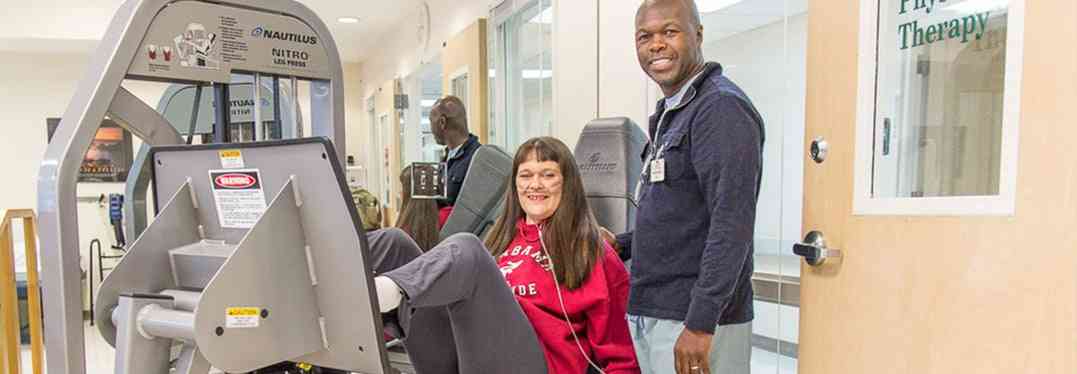If you have recently suffered a serious illness or injury, had surgery or experienced another significant medical incident, you may need physical therapy and/or other rehabilitative treatment to aid in having a complete and fast recovery. Chances are that as your treatment plan is underway, there will be some discussion of short term inpatient rehab versus outpatient therapy. Which of these options will best meet your recovery needs?
Since no two patients or situations are the same, there isn't a one-size-fits-all answer to that question. However, learning the essential facts about types of rehabilitative treatment and differences between them can help you make well-informed decisions about which treatment will help you achieve optimal recovery results.
Whether you or a loved one has recently experienced a serious illness or injury, had surgery, or had another significant medical incident, you may need physical therapy or another type of rehabilitative treatment to aid in recovery. Fill out the form to download our free guide.
Click a link to go directly to a specific section.
 Using an inpatient rehab program means staying in a facility for the rehabilitative therapy and care you need. This requires being admitted to a rehab program and staying there – similar to a regular hospital – until treatment is complete. The length of your stay may be anywhere from a few days to a month or more, depending upon your individual needs. These short term programs may be offered in stand-alone rehabilitation hospitals, specialized wings of acute-care hospitals, or in skilled nursing facilities. Individuals admitted to inpatient rehab facilities receive comprehensive rehabilitative care via a tightly-coordinated, physician-led multidisciplinary team of rehabilitative professionals. The team will typically include rehabilitative physicians and specialists, rehabilitation nursing staff, physical, occupational and speech therapists, nutritionists, social workers, counselors, and care coordinators, among others, according to the specific needs of each patient.
Using an inpatient rehab program means staying in a facility for the rehabilitative therapy and care you need. This requires being admitted to a rehab program and staying there – similar to a regular hospital – until treatment is complete. The length of your stay may be anywhere from a few days to a month or more, depending upon your individual needs. These short term programs may be offered in stand-alone rehabilitation hospitals, specialized wings of acute-care hospitals, or in skilled nursing facilities. Individuals admitted to inpatient rehab facilities receive comprehensive rehabilitative care via a tightly-coordinated, physician-led multidisciplinary team of rehabilitative professionals. The team will typically include rehabilitative physicians and specialists, rehabilitation nursing staff, physical, occupational and speech therapists, nutritionists, social workers, counselors, and care coordinators, among others, according to the specific needs of each patient.
Admission to an inpatient rehab program means that you will undergo intensive rehabilitative therapy, working with therapists for a minimum of three hours daily. You can also expect to have access to in-house rehab equipment, facilities and staff during your stay, giving you the opportunity to work toward your rehabilitation goals between therapy sessions in a safe, supervised environment. You will have 24-hour medical monitoring and care, including pain management and wound care, if necessary. All meals and personal care will be provided, and many inpatient rehab facilities offer a number of amenities, including indoor pools and/or spas, internet access and/or recreational facilities.

Using an outpatient rehab program to assist your recovery and rehabilitation means getting your therapy and treatment through a series of visits to a clinic or private therapy practice. Services available in an outpatient rehab program typically include physical, occupational, and speech therapy. Some outpatient programs may also offer the services of nutritionists, counselors, and other rehabilitation professionals to aid clients with recovery and rehabilitation.
Appointments may be scheduled anywhere from one to five days per week. Sessions usually last 30 minutes to an hour, and if you need more than one type of therapy, you may have to attend separate appointments with each therapist. In most cases, patients are expected to follow through with exercises and activities at home, between sessions, that are assigned to them by their therapists.
 Short-term inpatient rehab might be recommended as the best option for your recovery and rehabilitation under certain circumstances. For example, if you have suffered a serious injury or have had joint replacement or other complex orthopedic surgeries, inpatient rehab is a good option for you. In such cases, the intensive therapy and comprehensive care that rehab centers offer might be best for addressing your aftercare and rehabilitation needs to ensure that you can make your best – and safest – possible recovery.
Short-term inpatient rehab might be recommended as the best option for your recovery and rehabilitation under certain circumstances. For example, if you have suffered a serious injury or have had joint replacement or other complex orthopedic surgeries, inpatient rehab is a good option for you. In such cases, the intensive therapy and comprehensive care that rehab centers offer might be best for addressing your aftercare and rehabilitation needs to ensure that you can make your best – and safest – possible recovery.
If you are rehabilitating from a significant cardiovascular event, such as a heart attack or stroke, or have chronic health conditions that may complicate recovery from an injury or illness, staying in an inpatient facility might be wise. Under such circumstances, the close medical monitoring and comprehensive, multidisciplinary care offered in this setting is probably necessary to ensure the safest and most successful recovery.
Perhaps you live alone and an acute medical incident or degenerative disease – arthritis or osteoporosis, for example – has created significant impairments that make it impractical or unsafe for you to be immediately responsible for your own care. A stay in an inpatient rehab program can be just what you need to regain functional ability and/or learn to work around those impairments before you return home.
Perhaps your recovery and rehabilitation is time-sensitive due to obligations at work or home. Using an intensive inpatient rehab program can speed your progress, and meeting all your daily needs – meals, medications and care management – can free your time and energy to focus on your recovery. This can go a long way toward minimizing the time it takes to get back on your feet.
These are just a few examples that can make an inpatient rehab stay your best option as you recover from an illness or medical incident. If you are unsure about whether you are in need of this level of care, your healthcare providers or hospital discharge planners can help you figure things out to your best advantage.
An essential part of your recovery, inpatient rehab physical therapy can help many conditions, particularly these five.
Joint Replacement Recovery
For joint replacement therapy, inpatient rehab provides an option for a faster and more complete recovery. It can also reduce the risk for post-surgery complications and injuries by offering support throughout the recovery and rehab process.
Stroke Recovery
Based on guidelines from the American Stroke Association, inpatient rehab physical therapy provides the best possible environment for recovery from a stroke.
COPD
For help maintaining or improving lung capacity for those who have COPD, an inpatient rehab environment can provide a safe, medically supervised environment for patients to gradually increase their exercise tolerance with the help of physical therapy professionals.
Arthritis Management
Many people living with arthritis have benefited from inpatient rehab therapy. Through intensive physical therapy, patients can improve their strength and flexibility with muscles surrounding the affected joints.
Heart Attack Recovery
An inpatient program can serve as way for cardiac patients to recover more fully before returning home. Specifically, for heart attacks, patients are in a safe, medically supervised environment so that they can recover, regain strength, and learn heart-healthy exercises to reduce their risk of another cardiac event.
If you’re planning a joint replacement in the near future, planning for your recovery is an important step in the process. The care and therapy you receive following the procedure might be just as important as the surgery itself.
An inpatient rehab center treatment program could be a key step to recovering fully and quickly. A few benefits of inpatient care include:
An inpatient rehab center can also relieve some of the household tasks you typically might worry about such as grocery shopping, errands, meal preparation, cleaning up, and laundry.
If you’re considering inpatient or outpatient therapy for stroke recovery, there are a few options to evaluate before making a decision.
Outpatient treatment programs typically include an initial evaluation to assess therapeutic needs and then a treatment plan. From there, patients will typically need to go to one to three hour therapy sessions several times each week.
An inpatient treatment program is more intensive. Patients will check in to a short term rehab program, are evaluated by a team of specialists, who then recommend a treatment plan for their stay.
Beyond determining which option is right for a patient, there are also stroke rehabilitation guidelines. These guidelines state that stroke survivors typically benefit the most from rehabilitative care from a multi-disciplinary team. In addition, a minimum of three hours of therapy each day has also proven most effective for stroke rehabilitation.
Ultimately, the decision to pursue outpatient or inpatient rehab is up to the patient and their family and how much assistance they will need to recover to the best of their ability.
Inpatient treatment may be needed when someone experiences a cardiac event. Whether it’s a planned surgery or an event such as a heart attack, there are a few reasons it can be more beneficial than outpatient rehab.
First, there may be a need for close medical supervision and care. Once a patient leaves the hospital, they might not be ready to return to everyday life again. Inpatient cardiac care provides a safe and supportive environment in which to recover.
Surrounded by specialists, patients are able to go through the recovery process with 24/7 assistance.
This help comes in the form of a multidisciplinary team of cardiac care/rehabilitation professionals, including physicians, nursing staff, physical, occupational and speech therapists, psychologists, dietitians and care coordinators.
If you’re not sure whether or not inpatient care is right for you, it’s best to follow the recommendation of your doctor or healthcare team. If your doctor has made a recommendation for inpatient rehab, chances are it’s a good idea to at least consider.
There are four key reasons that inpatient care can be beneficial for managing your recovery. Discover if these reasons align with your recovery needs.

Easier recovery management
An inpatient short term rehab program provides you or a loved one with the professional care needed. This means your recovery can be the focus, while specialist can help with areas like wound care, medication management, and more.
Comprehensive, efficient, and highly coordinated care
In addition to the ease of an inpatient program, it also provides patients with a physician-led, multidisciplinary team of rehabilitation specialists. This means that all of your recovery is happening in one place and the staff can effectively communicate with one another.
Faster, more complete recovery
Through an inpatient short term rehab program, you’ll find a level of care that many outpatient programs lack. In addition to comprehensive care, you’ll also receive more intensive rehabilitative therapy. For example, patients in an outpatient program may see a therapist for about 30 minutes to an hour, 1-3 times per week. In comparison, in an inpatient program, patients receive a minimum of 3 hours of therapy on a daily basis.
Safety
Lastly, safety is another major factor with inpatient rehab. When released from the hospital, patients might be better but not necessarily ready to take care of themselves yet – which is why inpatient care is an ideal solution to prepare them to head back home.
In addition to the quality of care, there a few critical services patients receive when they enter an inpatient rehab treatment program. The following are an essential part of the recovery process:
Outpatient services might be a good option to aid in recovery and rehabilitation in cases of minor injuries, illnesses, or medical events. However, it is important to note that outpatient care is an option that is most appropriate for people who are confident that they have levels of strength, function, mobility, and independence to manage the details of their own care and recovery.
Here are some of the details you will probably need to handle on your own or with the help of family or friends should you choose to recover and rehabilitate in your home:
 This list does not cover every aspect of what you will need to manage during recovery, but it is a good starting point when evaluating whether or not recovering from home, with the support of outpatient services, is a practical solution for you. If you are unsure, your healthcare team and/or hospital discharge planner should be able to help you determine what your needs are and whether resources are available in your area to help you meet those needs safely, efficiently, and effectively.
This list does not cover every aspect of what you will need to manage during recovery, but it is a good starting point when evaluating whether or not recovering from home, with the support of outpatient services, is a practical solution for you. If you are unsure, your healthcare team and/or hospital discharge planner should be able to help you determine what your needs are and whether resources are available in your area to help you meet those needs safely, efficiently, and effectively.
 In a perfect world, decisions about inpatient versus outpatient therapy would be made according to your own medical, personal, and therapeutic needs and preferences. However, most of us must consider finances when making these decisions. So, what do you need to know about insurance coverage and your options for rehabilitative therapy and care?
In a perfect world, decisions about inpatient versus outpatient therapy would be made according to your own medical, personal, and therapeutic needs and preferences. However, most of us must consider finances when making these decisions. So, what do you need to know about insurance coverage and your options for rehabilitative therapy and care?
Most insurance companies, including government health insurance programs and commercial ones, will require you to present documentation showing that you have a medical need for rehabilitative services in order to get coverage for the cost. They will also ask for documentation that specifies what level of care is medically necessary for you, which will be used to determine which rehab options they will agree to cover.
In general, getting coverage for inpatient rehab means showing a need for intensive rehabilitative therapy and treatment, and/or around-the-clock medical/nursing care. You will also need to be deemed able to tolerate and benefit from participation in an intensive rehabilitation program. If documentation shows that a less intensive level of care is adequate for your needs and/or ability levels, outpatient rehab may be the only option that your insurance plan is willing to cover.
Given the essential role of medical documentation when deciding whether inpatient rehab or outpatient therapy will be covered by insurance, it is crucial to be open and honest with your healthcare team or discharge planners about your needs, preferences, and concerns in regard to your recovery. Be sure to discuss any difficulties or impairments that concern you. If you are in doubt about your ability to rehabilitate effectively at home, manage your own wound care and personal care, travel back and forth to appointments, or manage any other aspects of your recovery, share your concerns.
If safety may be an issue during the early days of recovery due to a lack of help and support at home, your medical team needs to know about that as well. All of these details are essential for an accurate assessment of your care needs, which will allow you to receive the coverage you need to pay for the appropriate level of rehabilitative care.

So, how do you know if your loved needs to spend time in an inpatient physical rehabilitation center?
As we shared earlier, there are a few differences between inpatient and outpatient care that will determine which one might be the right fit for your family member.
In general, inpatient care is more intensive than outpatient care. This might include a minimum of 3 hours of therapy daily, including physical, occupational, and speech therapy. It also offers comprehensive evaluation to ensure individualized treatment, and 24 hour medical/nursing care according to the individual needs of patients.
In contrast, outpatient rehabilitation services require only 2 or 3 days per week for therapy sessions that last 30 minutes to an hour.
Inpatient physical rehab is usually best for those with more serious functional impairments after an illness, injury or surgery, as well as individuals who have complex rehabilitative needs. Some situations that might require inpatient care include:
If you’re still not sure if inpatient rehabilitation is the right solution, contact Rehab Select to discuss available options.
